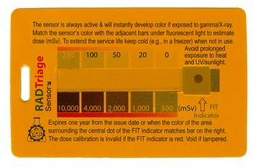Rad-Triage Dosimeters

RADTriage features a sensor (a rectangle strip between the color bars) with 50, 100 and 250 mSv bars on its top and 500, 1,000, 2,000, 4,000 and 10,000 mSv bars on its bottom for triaging information in emergencies. When exposed to radiation, the sensor of RADTriage develops color instantly. The color changes are permanent, cumulative and proportional to dose. The color of the radiated sensor is blue but appears gray with the red filter which facilitates dose reading for color blind people.
If the color of sensor has not changed, the wearer has not received signficant radiation exposure. If the sensor turns light gray color, a low radiation exposure is indicated. In this case, further exposure should be avoided. If the sensor has developed a darker gray color e.g., above 250 or 500 mSv, the user should contact a health physicist. A person exposed to dose higher than 500 mSv should receive immediate medical care.
The triage card features a color reference bar on the top right hand corner of the sensor to indicate expiration of the dosimeter’s usable life. The sensor will acquire color similar to that of the Expiration Bar after about two years of storage at room temperature or upon exposure to about 20 mSv. The sensor will expire if exposed to sunlight for an extended period of time.
Instructions
1. Write user name and date received on the back of the badge. The sensor’s color must be lighter than that of the Expiration Bar.
2. Carry RADTriage in wallet, purse or pocket. It me also be hung from the neck with a lanyard or on the belt .
3. RADTriage is a casualty radiation dosimeter. It supplements, but does not replace, other dosimeters or detectors that you may require to use.
4. Do not deliberately expose RADTriage to ionizing radiation. Protect RADTriage from high temperatures (above 60 deg C) and UV/sunlight for a prolonged period. This ensures the maximum usable life of the sensor.
5. The shelf life of this stockpileable RADTriage can be extended by keeping it in a freezer when not in use.
Types of Radiation: The RADTriage sensor responds to gamma/X-ray (energy higher than 30 KeV) and high energy (e.g., above 1 MeV) electrons/beta particles. Color development of the sensor is essentially independent of dose rate. However, protective films attenuate low energy (below 200 KeV) X-ray. RADTriage will not be affected by a normal exposure to diagnostic X-ray (e.g. chest or dental) or security X-ray machines. Multiple (more than five) exposures to medical or airport luggage CAT scans will result in sufficient exposure to produce a detectable color change in the sensor.
Dose Display
RADTriage: Estimate the exposure dose by comparing the color of the sensor with the color
reference bars. If the sensor develops a color in-between any two adjacent bars, this indicates an in-between dose. For the best results, read under a flourescent light source.
Laundry Cycle
Repeated laundry cycles or exposure to temperatures higher than 80 deg C will damage the sensors and must be avoided. Replace RADTriage if it is subjected to boiling water or more than one laundry cycle.
False Postive and Tamper Indicators: RADTriage is not equipped with the FIT indicator to monitor the false signals. If used as per instructions, it is least likely that RADTriage will provide false positives or negatives. Do not use the dosimeter if it was exposed to a temperature higher than 90 deg C or if the color of the sensor matches or becomes darker than that of the Expiration Bar.